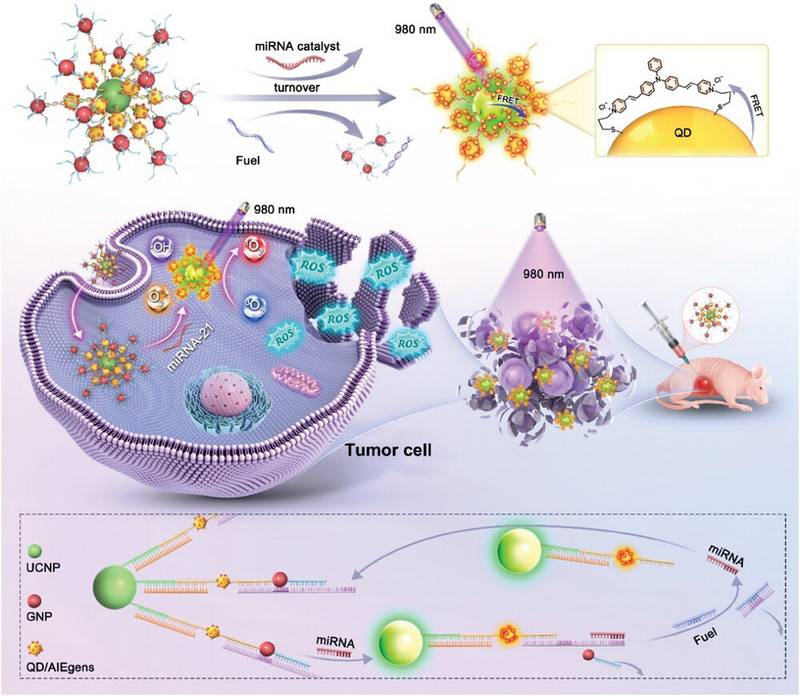DNA-Programmed (De)Hybridization of Near-Infrared Photosensitized UCNP-QDs-GNPs Nanoprobes for MicroRNA Imaging and Image-Guided Cancer Therapy
Jie Sun1, Jiangtao Geng1, Ben Zhong Tang2(唐本忠), Xuewen He1(何学文)
1The Key Lab of Health Chemistry and Molecular Diagnosis of Suzhou, College of Chemistry, Chemical Engineering and Materials Science, Soochow University, Suzhou, 215123 China
2School of Science and Engineering, Shenzhen Institute of Aggregate Science and Technology, The Chinese University of Hong Kong, Shenzhen (CUHK-Shenzhen), Shenzhen, Guangdong, 518172 China
Adv. Funct. Mater. 2024, 34, 2315299
Abstract: Accurate and sensitive analysis of cancer-associated microRNAs in living tissue is of great significance for the early diagnosis and treatment of cancer. Herein, a hierarchical nanoprobe denoted as UCNP-QDs-GNPs is delicately designed, where a near-infrared (NIR) absorptive upconversion nanoparticle (UCNP) serves as the core, broad-absorptive and bright emissive quantum dots (QDs) and emission-quencher gold nanoparticles (GNPs) surround as satellites for microRNA imaging and image-guided cancer therapy. Through the programmed assembly of heterobivalent DNA-conjugated QDs with DNA-modified GNPs and UCNPs, the well-defined nanostructured UCNP-QDs-GNPs are generated with quenched fluorescence. Upon encountering the microRNA-21 target, GNPs underwent catalytic disassembly, resulting in the concurrent recovery and amplification of fluorescence from QDs and UCNPs, which enabled sensitive imaging and quantification of microRNA-21 within living cells. Furthermore, dithiol-constituted aggregation-induced emission (AIE) photosensitizers bonded on the surface of QDs, are effectively photosensitized by the QDs. The NIR excitation harvested by UCNPs is therefore efficiently transferred to QDs and subsequently converged on the AIE photosensitizers, boosting photodynamic activity for image-guided therapy in deep-seated tumors. The DNA-programmed (de)hybridization strategy, facilitating the conversion of NIR excitation into imaging signals and photodynamic activity, offers a promising avenue for the early theranostics of malignancies.

链接://onlinelibrary.wiley.com/doi/10.1002/adfm.202315299